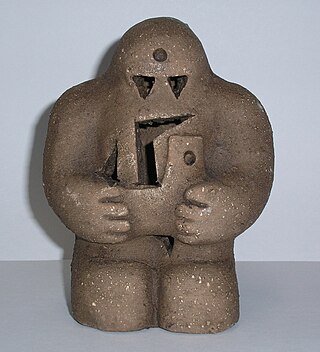
A golem is an animated anthropomorphic being in Jewish folklore, which is created entirely from inanimate matter, usually clay or mud. The most famous golem narrative involves Judah Loew ben Bezalel, the late 16th-century rabbi of Prague. According to Moment magazine, "the golem is a highly mutable metaphor with seemingly limitless symbolism. It can be a victim or villain, man or woman—or sometimes both. Over the centuries, it has been used to connote war, community, isolation, hope, and despair."

Jorge Francisco Isidoro Luis Borges Acevedo was an Argentine short-story writer, essayist, poet and translator regarded as a key figure in Spanish-language and international literature. His best-known works, Ficciones (transl. Fictions) and El Aleph, published in the 1940s, are collections of short stories exploring motifs such as dreams, labyrinths, chance, infinity, archives, mirrors, fictional writers and mythology. Borges's works have contributed to philosophical literature and the fantasy genre, and have had a major influence on the magic realist movement in 20th century Latin American literature.
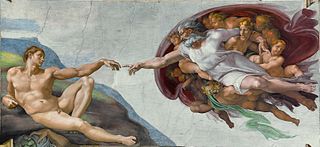
The Omphalos hypothesis is one attempt to reconcile the scientific evidence that the Earth is billions of years old with a literal interpretation of the Genesis creation narrative, which implies that the Earth is only a few thousand years old. It is based on the religious belief that the universe was created by a divine being, within the past six to ten thousand years, and that the presence of objective, verifiable evidence that the universe is older than approximately ten millennia is due to the creator introducing false evidence that makes the universe appear significantly older.

Judah Loew ben Bezalel, also known as Rabbi Loew, the Maharal of Prague, or simply the Maharal, was an important Talmudic scholar, Jewish mystic, mathematician, astronomer, and philosopher who, for most of his life, served as a leading rabbi in the cities of Mikulov in Moravia and Prague in Bohemia.

The Kuzari, full title Book of Refutation and Proof on Behalf of the Despised Religion, also known as the Book of the Khazar, is one of the most famous works of the medieval Spanish Jewish philosopher, physician, and poet Judah Halevi, completed in the Hebrew year 4900 (1139-40CE).
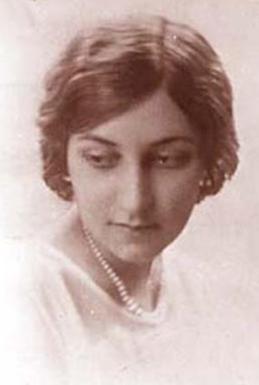
Leonor Fanny "Norah" Borges Acevedo, was an Argentine visual artist and art critic, member of the Florida group, and sister of the Argentine writer Jorge Luis Borges.

Gershom Scholem was a German-born Israeli philosopher and historian. Widely regarded as the founder of modern academic study of the Kabbalah, Scholem was appointed the first professor of Jewish mysticism at Hebrew University of Jerusalem.
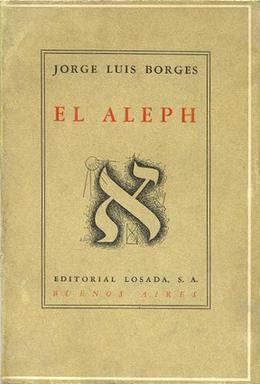
The Aleph and Other Stories is a book of short stories by Argentine writer Jorge Luis Borges. The title work, "The Aleph", describes a point in space that contains all other spaces at once. The work also presents the idea of infinite time. Borges writes in the original afterword, dated May 3, 1949, that most of the stories belong to the genre of fantasy, mentioning themes such as identity and immortality. Borges added four new stories to the collection in the 1952 edition, for which he provided a brief postscript to the afterword. The story "La intrusa" was first printed in the third edition of El Aleph (1966) and was later included in the collection El informe de Brodie (1970).

Emir Rodríguez Monegal, born in Uruguay, was a scholar, literary critic, and editor of Latin American literature. From 1969 to 1985, Rodríguez Monegal was professor of Latin American contemporary literature at Yale University. He is usually called by his second surname Emir R. Monegal or Monegal.
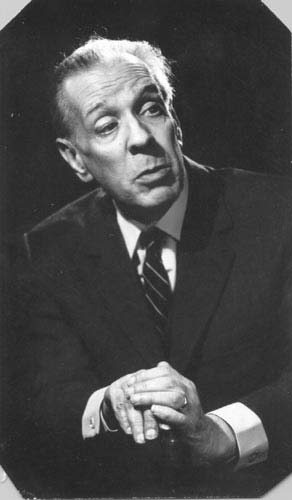
This is a bibliography of works by Argentine short-story writer, essayist, poet, and translator Jorge Luis Borges (1899–1986).
"The Secret Miracle" is a short story by Argentine writer and poet Jorge Luis Borges. The story focuses on an author condemned to death. At the moment of his execution, time freezes, allowing him to finish his masterpiece, though only within his own mind.
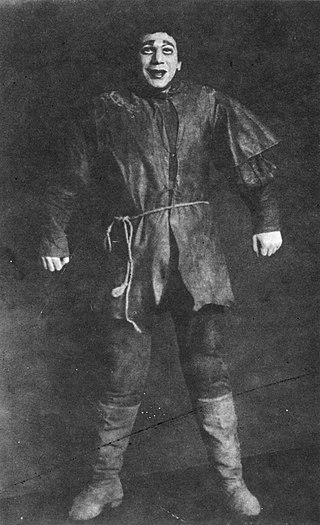
The Golem is a 1921 "dramatic poem in eight scenes" by H. Leivick. The story is a reworking of a legend of Judah Loew ben Bezalel, known as the Maharal, a great rabbi of Prague. In the legend, he animates a golem, a being crafted from inanimate material. The same legends had provided the ground for Gustav Meyrink's 1915 novel of the same name.

Macedonio Fernández was an Argentine writer, humorist and philosopher. His writings included novels, stories, poetry, journalism, and works not easily classified. He was a mentor to Jorge Luis Borges and other avant-garde Argentine writers. Seventeen years of his correspondence with Borges was published in 2000. His published poetry includes "Creía yo".
Shem HaMephorash, meaning "the explicit name," was originally a Tannaitic term for the Tetragrammaton. In Kabbalah, it may refer to a name of God composed of either 4, 12, 22, 42, or 72 letters, the latter version being the most common.

"The Circular Ruins" is a short story by Argentine author Jorge Luis Borges. First published in the literary journal Sur in December 1940, it was included in the 1941 collection The Garden of Forking Paths and the 1944 collection Ficciones. It was first published in English in View, translated by Paul Bowles. Since publication, it has become one of Borges's best-known stories.

Elijah Benamozegh, sometimes Elia or Eliyahu, was an Italian Sephardic Orthodox rabbi and renowned Jewish Kabbalist, highly respected in his day as one of Italy's most eminent Jewish scholars. He served for half a century as rabbi of the important Jewish community of Livorno, where the "Piazza Benamozegh" now commemorates his name and distinction. His major work is Israel and Humanity (1863), which was translated into English by Dr. Mordechai Luria in 1995.
Christian Kabbalah arose during the Renaissance due to Christian scholars' interest in the mysticism of Jewish Kabbalah, which they interpreted according to Christian theology. It is often transliterated as Cabala to distinguish it from the Jewish form and from Hermetic Qabalah.
Practical Kabbalah in historical Judaism, is a branch of the Jewish mystical tradition that concerns the use of magic. It was considered permitted white magic by its practitioners, reserved for the elite, who could separate its spiritual source from qlippoth realms of evil if performed under circumstances that were holy (Q-D-Š) and pure, tumah and taharah. The concern of overstepping Judaism's strong prohibitions of impure magic ensured it remained a minor tradition in Jewish history. Its teachings include the use of Divine and angelic names for amulets and incantations.

Harto the Borges is a documentary film by Eduardo Montes-Bradley. Harto the Borges explores the narcissistic side of Jorge Luis Borges, the author of El Aleph, his frequent and often criticized comments to the press, his distinctive and gentle ironies. Harto The Borges had a theatrical release in Buenos Aires in September 2000, and was well received by the critics. Since then has been frequently exhibited at forums, campuses, and film festivals. On October 4, 2011, Harto the Borges was presented at the University of Salamanca, and made available to the general audience in Argentina through the On Line version of Revista Cultura Ñ, in Buenos Aires. The film was released alongside an article in which the director views the film ten years after its premier at the Cine Cosmos. The film is currently available in Vimeo. Harto the Borges was presented at the Festival Internacional del Nuevo Cine Latinoamericano, Havana, Cuba, 2000 and nominated for Premio Cóndor de Plata.
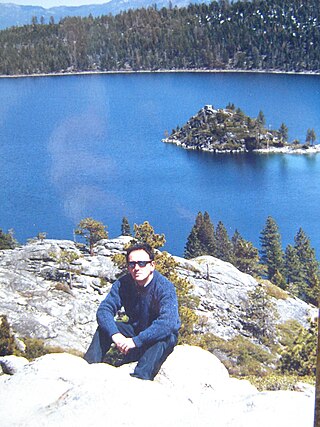
Edgar Brau is an Argentine writer, stage director and artist.















